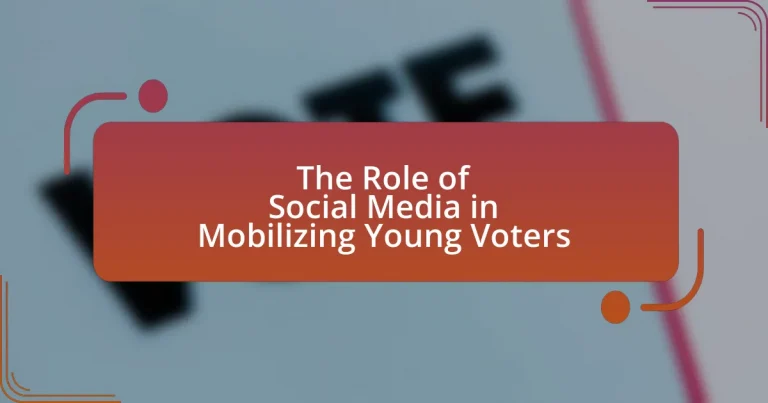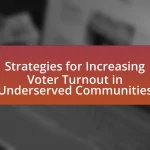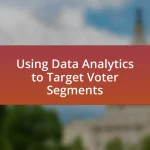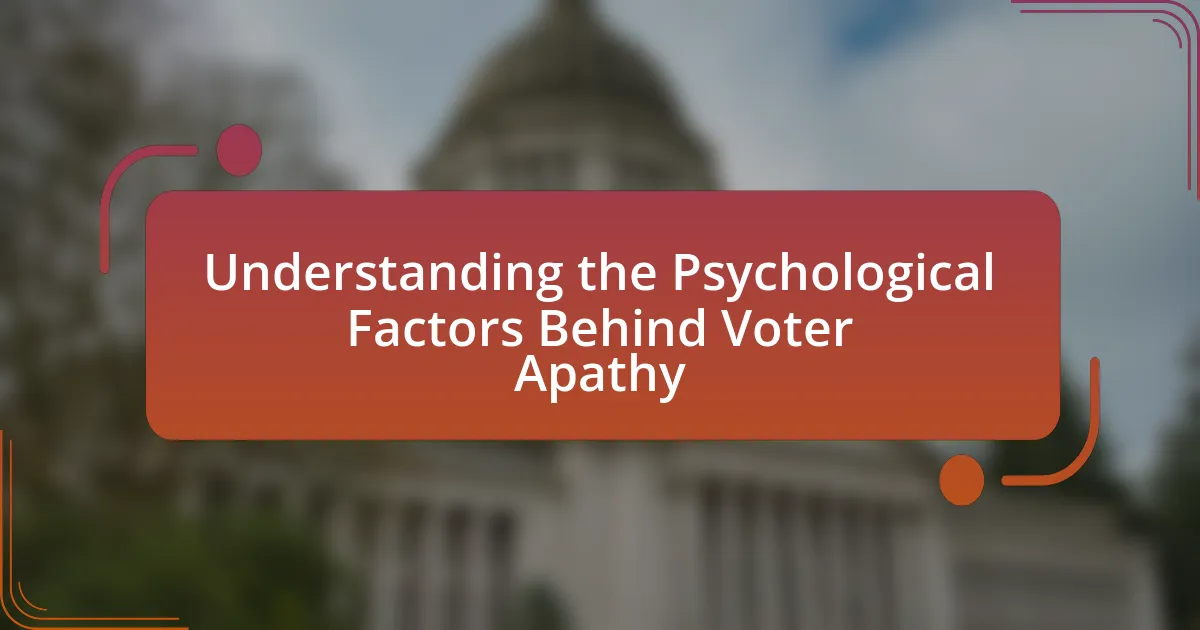The article examines the critical role of social media in mobilizing young voters, highlighting its effectiveness as a platform for information dissemination, engagement, and community building. It discusses how platforms like Instagram, TikTok, and Twitter are utilized by young voters to gather information, influence political opinions, and enhance voter turnout, particularly during elections. The article also addresses the challenges young voters face, such as misinformation and privacy concerns, while emphasizing the importance of targeted messaging and data analytics in improving social media strategies for voter mobilization. Additionally, it explores the impact of peer influence and the role of influencers in encouraging civic engagement among youth.

What is the Role of Social Media in Mobilizing Young Voters?
Social media plays a crucial role in mobilizing young voters by providing a platform for information dissemination, engagement, and community building. It enables political campaigns to reach younger demographics effectively, as 84% of individuals aged 18-29 use social media, according to the Pew Research Center. This demographic utilizes platforms like Instagram, Twitter, and TikTok to share political content, discuss issues, and organize events, which enhances voter turnout. Additionally, social media facilitates peer influence, as young voters are more likely to participate in elections when they see their friends and influencers advocating for civic engagement.
How does social media influence young voter engagement?
Social media significantly enhances young voter engagement by providing a platform for information dissemination and community building. Research indicates that 71% of young voters use social media to gather information about candidates and issues, which directly influences their voting decisions. Additionally, social media campaigns can mobilize young voters through targeted messaging and peer influence, as seen in the 2020 U.S. presidential election where platforms like Instagram and TikTok played crucial roles in encouraging voter registration and turnout among younger demographics.
What platforms are most effective for reaching young voters?
Social media platforms such as Instagram, TikTok, and Snapchat are most effective for reaching young voters. These platforms have high engagement rates among younger demographics, with 71% of young adults aged 18-29 using Instagram and 60% using TikTok as of 2023. Research indicates that visual content and short videos resonate well with this age group, making these platforms ideal for political messaging and mobilization efforts. Additionally, a study by the Pew Research Center found that 50% of young voters reported being influenced by social media when deciding how to vote, underscoring the importance of these platforms in political outreach.
How do social media campaigns differ from traditional campaigning?
Social media campaigns differ from traditional campaigning primarily in their reach and engagement methods. Social media allows for real-time interaction and feedback, enabling campaigns to engage directly with voters, particularly young voters, through platforms like Instagram and Twitter. In contrast, traditional campaigning relies on one-way communication methods such as television ads, print media, and direct mail, which do not facilitate immediate interaction. According to a Pew Research Center study, 71% of young adults use social media, highlighting its effectiveness in reaching this demographic compared to traditional methods, which often fail to engage younger audiences effectively.
Why is social media important for young voters?
Social media is important for young voters because it serves as a primary platform for political engagement and information dissemination. Young voters, who are typically more active on platforms like Instagram, Twitter, and TikTok, utilize these channels to access news, connect with political campaigns, and mobilize for voting initiatives. According to a 2020 Pew Research Center study, 50% of young adults aged 18-29 reported that social media significantly influenced their political views and voting decisions. This demonstrates that social media not only informs but also empowers young voters to participate in the electoral process.
What demographic trends are evident in young voter participation?
Young voter participation shows significant demographic trends, particularly in increased engagement among diverse racial and ethnic groups. For instance, data from the U.S. Census Bureau indicates that in the 2020 election, 50% of eligible voters aged 18-29 participated, with notable increases among Black and Hispanic voters compared to previous elections. This trend reflects a growing awareness and mobilization efforts, often facilitated by social media platforms, which have been instrumental in reaching and informing young voters about issues that resonate with them, such as climate change and social justice. Additionally, studies, including those from the Pew Research Center, highlight that young voters are more likely to engage politically through digital means, further emphasizing the role of social media in shaping their voting behaviors and preferences.
How does social media shape political opinions among youth?
Social media significantly shapes political opinions among youth by providing a platform for information dissemination, discussion, and engagement. Research indicates that 70% of young people use social media as their primary source of news, influencing their perceptions of political issues and candidates. Platforms like Twitter and Instagram facilitate the rapid spread of political content, allowing youth to engage with diverse viewpoints and mobilize around causes. Additionally, studies show that social media campaigns can increase political participation among young voters, with 50% of users reporting that social media influenced their voting decisions in recent elections.
What challenges do young voters face in mobilization through social media?
Young voters face several challenges in mobilization through social media, including misinformation, digital divide, and engagement fatigue. Misinformation can lead to confusion and distrust, as studies show that false information spreads rapidly on platforms like Facebook and Twitter, impacting voter perceptions and decisions. The digital divide presents a barrier, as not all young individuals have equal access to technology or the internet, which can limit their ability to engage with mobilization efforts. Additionally, engagement fatigue occurs when young voters become overwhelmed by the volume of content and calls to action, leading to apathy and reduced participation. These challenges hinder effective mobilization and can significantly affect young voter turnout.
What misinformation issues arise on social media platforms?
Misinformation issues on social media platforms include the rapid spread of false information, manipulation of public opinion, and the undermining of trust in credible sources. These platforms facilitate the viral dissemination of misleading content, often driven by algorithms that prioritize engagement over accuracy. A study by the Massachusetts Institute of Technology found that false news stories are 70% more likely to be retweeted than true stories, highlighting the significant impact of misinformation on user behavior and public discourse. Additionally, misinformation can lead to polarization, as users may gravitate towards echo chambers that reinforce their beliefs, further complicating the landscape of informed voting among young voters.
How do privacy concerns affect young voters’ engagement?
Privacy concerns significantly decrease young voters’ engagement in political processes. Research indicates that young individuals are increasingly wary of how their personal data is collected and used by social media platforms, which can lead to distrust in political messaging and campaigns. A study by the Pew Research Center found that 70% of young adults are concerned about how their data is being used, which directly correlates with lower participation rates in voting and political discussions. This apprehension can result in reduced interaction with political content on social media, ultimately diminishing their overall engagement in the electoral process.
How can social media strategies be improved for better mobilization?
Social media strategies can be improved for better mobilization by utilizing targeted messaging and data analytics to engage young voters effectively. Tailoring content to resonate with specific demographics increases relevance, as evidenced by a study from the Pew Research Center, which found that 71% of young adults use social media to connect with political issues. Additionally, employing interactive elements such as polls and live Q&A sessions fosters engagement, leading to higher participation rates. Research from the Knight Foundation indicates that interactive content can increase user engagement by up to 50%. By leveraging these strategies, organizations can enhance their mobilization efforts among young voters.
What best practices should organizations follow when targeting young voters?
Organizations should prioritize authenticity and engagement when targeting young voters. Young voters respond positively to genuine communication and relatable content, which can be achieved through storytelling and real-life examples. Research indicates that 70% of young voters are influenced by social media interactions, highlighting the importance of platforms like Instagram and TikTok for outreach. Additionally, organizations should utilize data analytics to tailor messages that resonate with specific demographics within the youth population, ensuring that campaigns are relevant and impactful. Engaging young voters through interactive content, such as polls and live Q&A sessions, can further enhance participation and interest in civic engagement.
How can data analytics enhance social media campaigns for youth mobilization?
Data analytics can enhance social media campaigns for youth mobilization by providing insights into audience behavior and preferences, allowing for targeted messaging. By analyzing engagement metrics, such as likes, shares, and comments, campaign managers can identify which content resonates most with young voters. For instance, a study by the Pew Research Center found that 71% of young adults use social media to engage with political content, indicating the platform’s effectiveness for mobilization. Additionally, data analytics can segment audiences based on demographics and interests, enabling campaigns to tailor their strategies and increase participation rates. This targeted approach has been shown to improve campaign effectiveness, as evidenced by the successful use of data-driven strategies in the 2020 U.S. presidential election, where campaigns utilized analytics to reach younger voters more effectively.
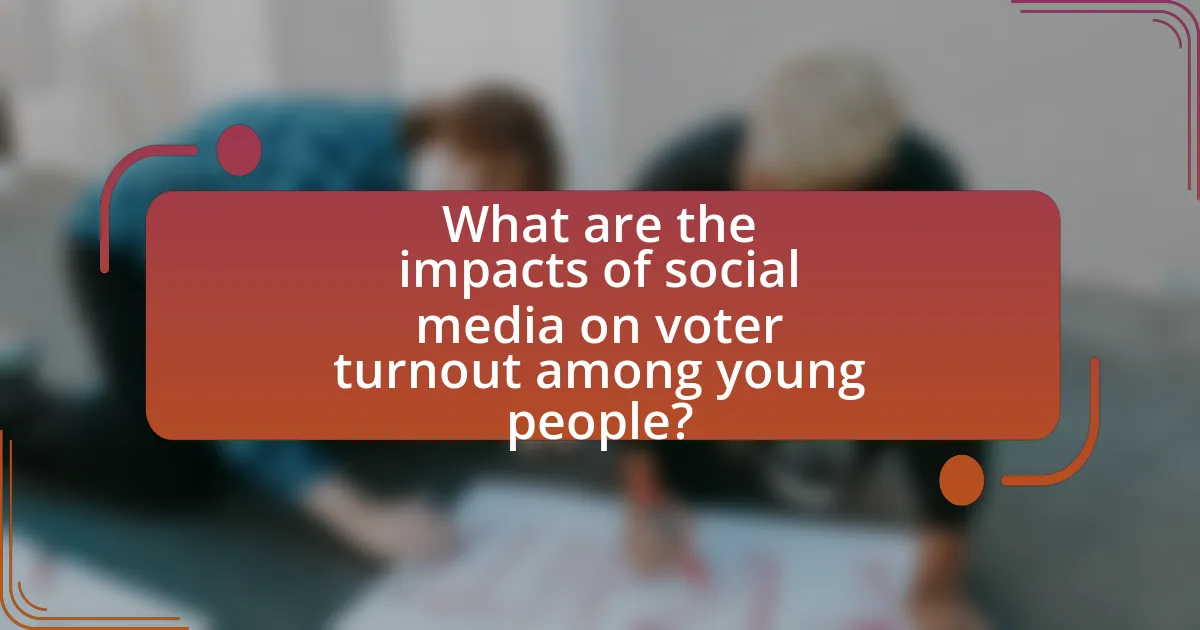
What are the impacts of social media on voter turnout among young people?
Social media significantly increases voter turnout among young people by facilitating engagement and information dissemination. Studies indicate that young voters who engage with political content on platforms like Facebook and Twitter are more likely to participate in elections. For instance, a report by the Pew Research Center found that 50% of young adults aged 18-29 reported being influenced by social media to vote in the 2020 U.S. presidential election. Additionally, social media campaigns often utilize targeted messaging and peer influence, which effectively mobilizes this demographic. The combination of accessible information and social interaction on these platforms creates a conducive environment for higher voter participation among young individuals.
How does social media affect the likelihood of young voters participating in elections?
Social media significantly increases the likelihood of young voters participating in elections by providing accessible information and fostering engagement. Research indicates that platforms like Facebook and Instagram serve as vital tools for political campaigns to reach younger demographics, with 50% of young voters reporting that social media influenced their decision to vote in the 2020 U.S. elections. Additionally, social media facilitates peer-to-peer communication, which can enhance motivation and mobilization, as seen in studies showing that young people are more likely to vote when they see their friends discussing political issues online.
What evidence supports the correlation between social media use and voter turnout?
Research indicates a positive correlation between social media use and voter turnout, particularly among young voters. A study conducted by the Pew Research Center in 2020 found that 69% of U.S. adults reported using social media, with 50% of those users stating that social media influenced their decision to vote. Furthermore, a 2018 analysis published in the Journal of Communication demonstrated that social media campaigns significantly increased voter registration and turnout rates, with specific emphasis on platforms like Facebook and Twitter. These platforms facilitate political engagement by providing information, mobilizing peer networks, and encouraging discussions about voting, thereby enhancing civic participation among younger demographics.
How do peer influences on social media drive voter participation?
Peer influences on social media significantly drive voter participation by creating a sense of community and shared responsibility among users. When individuals observe their peers discussing, endorsing, or participating in voting, they are more likely to feel motivated to engage in the electoral process themselves. Research indicates that social media platforms amplify these peer effects; for instance, a study by the Pew Research Center found that 50% of social media users reported being influenced by friends’ posts about voting. This peer-driven engagement can lead to increased turnout, particularly among young voters, as they often rely on social networks for information and validation regarding civic participation.
What role do influencers play in mobilizing young voters on social media?
Influencers play a crucial role in mobilizing young voters on social media by leveraging their reach and credibility to engage and inform this demographic. They create relatable content that resonates with young audiences, often addressing issues that matter to them, such as climate change, social justice, and education. For instance, a study by the Pew Research Center found that 71% of young adults aged 18-29 use social media as a primary source of news, highlighting the platform’s significance in shaping political opinions. Influencers can effectively encourage voter registration and participation by sharing personal stories, promoting civic engagement, and providing information on how to vote, thus driving higher turnout rates among young voters.
How can influencers effectively communicate political messages?
Influencers can effectively communicate political messages by leveraging their established trust and relatability with their audience. They can utilize storytelling techniques to present complex political issues in an engaging manner, making them more accessible to young voters. For instance, influencers can share personal experiences related to political topics, which can resonate emotionally with their followers, thereby increasing engagement and understanding. Research indicates that 70% of young voters are influenced by social media personalities when forming political opinions, highlighting the significant impact influencers have in shaping political discourse.
What are the risks associated with influencer-led campaigns?
Influencer-led campaigns carry several risks, including potential reputational damage, lack of authenticity, and regulatory compliance issues. Reputational damage can occur if an influencer engages in controversial behavior or makes statements that conflict with the brand’s values, leading to public backlash. Lack of authenticity arises when influencers promote products or causes they do not genuinely support, which can alienate their audience and diminish trust. Regulatory compliance issues may arise from failing to disclose paid partnerships, which can result in legal penalties and loss of credibility. According to a 2021 survey by the Digital Marketing Institute, 61% of consumers are less likely to trust brands that do not disclose influencer partnerships, highlighting the importance of transparency in influencer marketing.
How can social media be used to educate young voters?
Social media can be used to educate young voters by providing accessible information about the electoral process, candidates, and key issues. Platforms like Instagram, Twitter, and TikTok allow organizations and influencers to share concise, engaging content that simplifies complex political topics, making them more relatable to younger audiences. For instance, a study by the Pew Research Center found that 69% of young adults aged 18-29 use social media as a primary source for news, highlighting its effectiveness in reaching this demographic. Additionally, interactive features such as polls, Q&A sessions, and live discussions can foster engagement and encourage young voters to seek out further information, thereby enhancing their understanding of the political landscape.
What types of content resonate most with young voters?
Engaging and authentic content resonates most with young voters. This demographic responds positively to content that reflects their values, such as social justice, climate change, and equality. Research indicates that 70% of young voters prefer content that includes personal stories and relatable experiences, which fosters a sense of connection and urgency. Additionally, visual content, particularly videos and memes, is highly effective; studies show that 85% of young voters engage more with video content on platforms like Instagram and TikTok. This preference for authentic, value-driven, and visually appealing content underscores the importance of tailoring messaging to align with the interests and concerns of young voters.
How can interactive features on social media enhance voter education?
Interactive features on social media enhance voter education by facilitating real-time engagement and information dissemination. These features, such as polls, quizzes, and live Q&A sessions, allow users to actively participate in discussions about voting issues, thereby increasing their understanding of the electoral process. For instance, a study by the Pew Research Center found that 70% of young voters reported using social media to learn about candidates and issues, indicating that interactive content significantly boosts their knowledge and engagement. Additionally, platforms like Instagram and Twitter enable organizations to share informative graphics and videos that simplify complex voting information, making it more accessible to a younger audience.
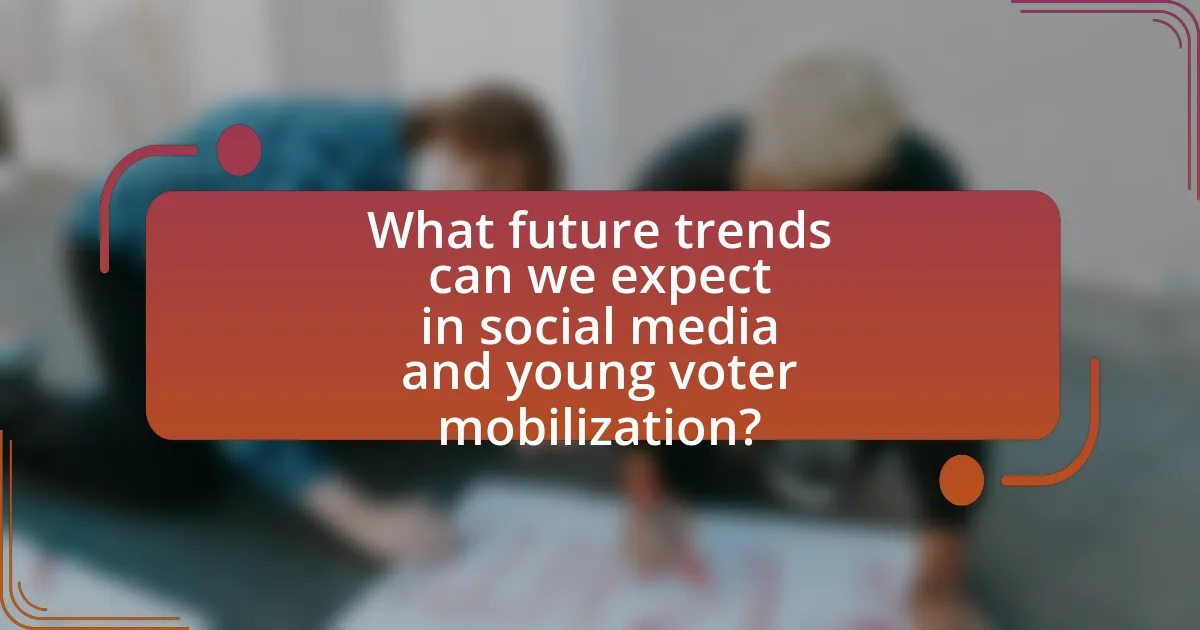
What future trends can we expect in social media and young voter mobilization?
Future trends in social media and young voter mobilization will likely include increased use of short-form video content and personalized messaging. Platforms like TikTok and Instagram are becoming primary channels for engaging young voters, as they favor dynamic and visually appealing content. Research indicates that 60% of young voters are influenced by social media when deciding how to vote, highlighting its critical role in mobilization efforts. Additionally, the integration of artificial intelligence in targeting specific demographics will enhance the effectiveness of campaigns, allowing for tailored messages that resonate with individual values and interests.
How is technology evolving to support young voter engagement on social media?
Technology is evolving to support young voter engagement on social media through the development of targeted outreach tools and interactive platforms. These advancements include algorithms that analyze user behavior to deliver personalized content, making political information more accessible and relevant to young voters. For instance, platforms like Instagram and TikTok have introduced features that allow organizations to create engaging, short-form videos that resonate with younger audiences, increasing the likelihood of sharing and participation. Additionally, data from the Pew Research Center indicates that 84% of young adults aged 18-29 use social media, highlighting its critical role in shaping political opinions and mobilizing voter turnout.
What emerging platforms could influence future voter mobilization efforts?
Emerging platforms that could influence future voter mobilization efforts include TikTok, Discord, and Clubhouse. TikTok’s short-form video content allows for creative and engaging political messaging, reaching younger audiences effectively; for instance, the platform saw a surge in political content during the 2020 U.S. elections, with users creating viral videos that encouraged voter registration. Discord, originally a gaming communication tool, has evolved into a space for community organizing and discussion, enabling grassroots movements to mobilize supporters through dedicated servers. Clubhouse, an audio-based social networking app, facilitates real-time discussions and debates, allowing political figures and activists to engage directly with voters, fostering a sense of community and urgency around electoral participation. These platforms leverage unique formats and user engagement strategies to enhance voter mobilization efforts among younger demographics.
How might changes in social media algorithms affect young voter outreach?
Changes in social media algorithms can significantly impact young voter outreach by altering the visibility of political content. When algorithms prioritize certain types of posts, they can either enhance or limit the exposure of voter mobilization messages aimed at young audiences. For instance, a study by the Pew Research Center found that 71% of young adults use social media as a primary source for political news, indicating that algorithm changes directly influence their engagement with electoral information. If algorithms favor content that resonates with young voters, outreach efforts can become more effective, leading to higher participation rates. Conversely, if algorithms suppress such content, it may result in decreased awareness and lower voter turnout among this demographic.
What practical strategies can organizations implement to leverage social media for young voter mobilization?
Organizations can implement targeted social media campaigns to effectively mobilize young voters. These campaigns should utilize platforms popular among youth, such as Instagram, TikTok, and Snapchat, to share engaging content that resonates with their interests and values. For instance, using visually appealing graphics, short videos, and interactive polls can increase engagement and awareness about voting issues.
Additionally, organizations can collaborate with influencers who have a strong following among young audiences to amplify their messages. Research indicates that 50% of young voters are influenced by social media personalities, making this a powerful strategy for outreach.
Furthermore, providing clear information on how to register and vote through social media posts can simplify the process for young voters. A study by the Pew Research Center found that 71% of young adults use social media to gather information about political issues, highlighting the importance of accessible and informative content.
By combining these strategies, organizations can create a comprehensive approach to mobilizing young voters through social media effectively.
What tools are available for measuring the effectiveness of social media campaigns?
Tools available for measuring the effectiveness of social media campaigns include Google Analytics, Hootsuite, Sprout Social, and Buffer. Google Analytics tracks website traffic and user behavior originating from social media platforms, providing insights into conversion rates and user engagement. Hootsuite offers social media management and analytics, allowing users to monitor engagement metrics across multiple platforms. Sprout Social provides in-depth reporting on audience demographics, engagement, and post-performance, enabling brands to assess their social media impact. Buffer focuses on scheduling posts and analyzing performance metrics, helping users understand which content resonates most with their audience. These tools collectively offer comprehensive data that can validate the effectiveness of social media campaigns in mobilizing young voters.
How can organizations build a community around young voters on social media?
Organizations can build a community around young voters on social media by creating engaging, relatable content that resonates with their interests and values. This involves utilizing platforms like Instagram, TikTok, and Twitter to share informative posts, interactive polls, and live discussions that encourage participation. Research indicates that 84% of young voters use social media to engage with political content, highlighting its effectiveness in reaching this demographic. By fostering a sense of belonging through targeted campaigns and user-generated content, organizations can enhance community engagement and mobilization efforts among young voters.
